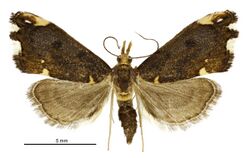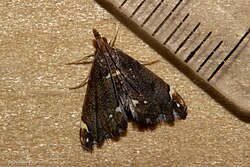Biology:Glaucocharis pyrsophanes
From HandWiki
Short description: Species of moth
| Glaucocharis pyrsophanes | |
|---|---|

| |
| Scientific classification | |
| Domain: | Eukaryota |
| Kingdom: | Animalia |
| Phylum: | Arthropoda |
| Class: | Insecta |
| Order: | Lepidoptera |
| Family: | Crambidae |
| Subfamily: | Crambinae |
| Tribe: | Diptychophorini |
| Genus: | Glaucocharis |
| Species: | G. pyrsophanes
|
| Binomial name | |
| Glaucocharis pyrsophanes (Meyrick, 1882)[1]
| |
| Synonyms[1] | |
| |
Glaucocharis pyrsophanes is a moth in the family Crambidae.[2] It was described by Edward Meyrick in 1882. It is endemic to New Zealand.
Taxonomy
This species was first described by Edward Meyrick in 1882 and named Diptychophora pyrsophanes.[3] Meyrick gave a fuller description of this species in 1883.[4] The female lectotype, collected at the Wellington Botanic Garden by Meyrick, is held at the Natural History Museum, London.[5]
Description
Meyrick described this species as follows:
Male, female. — 13 1⁄2-16 mm. Head ochreous or brownish - ochreous. Palpi light yellowish-ochreous, externally more brownish. Antennae dark fuscous. Thorax rather dark purplish-fuscous. Abdomen dark purplish-fuscous, with a light yellowish ring near base. Legs clear whitish-ochreous. Forewings triangular, very broad posteriorly, costa very gently arched, apex rounded, hindmargin oblique, indentations moderately deep ; ochreous-brown, almost wholly suffused with dark purplish-fuscous except narrowly along hindmargin and more broadly at apex and anal angle, and finely irrorated with grey, especially towards costa and disc beyond middle ; a very small triangular yellow spot on inner margin at 1⁄4 ; an equally small rather subquadrate yellow spot on inner margin at 3⁄4 , with a pale yellow dot rather above and beyond its apex ; a very faintly perceptible darker transverse line from costa at 1⁄4 to first dorsal spot, sharply angulated outwards beneath costa ; a suffused darker spot in disc above and beyond middle ; a small outwardly oblique triangular pale yellow spot on costa at 3⁄4 , sometimes closely preceded by a faint oblique yellowish costal mark ; a very small suffused pale yellowish spot on costa before apex ; a dark fuscous dot in apex, preceded by a clear white dot; sometimes a white dot on hind margin in upper indentation ; a slender dark fuscous hindmarginal line : cilia whitish ochreous, with a dark grey line near base, on indentations wholly clear white, a dark grey spot at apex, another between indentations, a third above anal angle, a fourth on anal angle. Hindwings fuscous-grey, with a very indistinct darker line posteriorly ; a dark fuscous hindmarginalline ; cilia grey- whitish, with a grey line near base.[4]
Distribution
This species is endemic to New Zealand.[1]
Behaviour
Adults of this moth are known to pollinate Leptospermum scoparium and Helichrysum selago.[6]
References
- ↑ 1.0 1.1 1.2 "NZOR Name Details - Glaucocharis pyrsophanes (Meyrick, 1882)". Landcare Research New Zealand Ltd. http://www.nzor.org.nz/names/58ecc98e-7d5a-4b1c-a4da-461a565b743e. Retrieved 20 January 2018.
- ↑ , p. 457, Wikidata Q45922947
- ↑ , pp. 186, Wikidata Q115108516
- ↑ 4.0 4.1 , pp. 11-12, Wikidata Q111013914
- ↑ , pp. 145, Wikidata Q45083134
- ↑ , Wikidata Q54669862
Wikidata ☰ Q13642969 entry
 |


